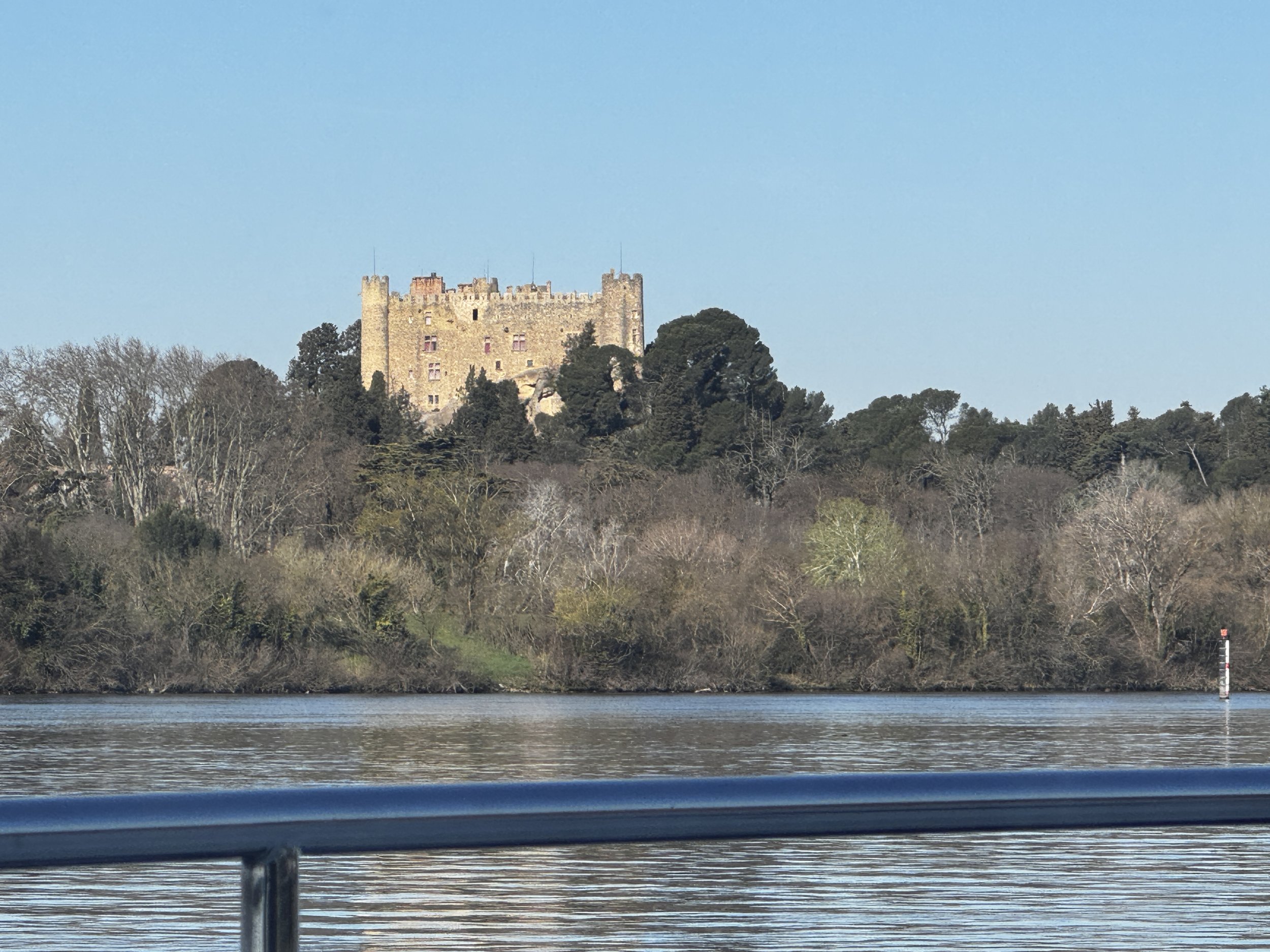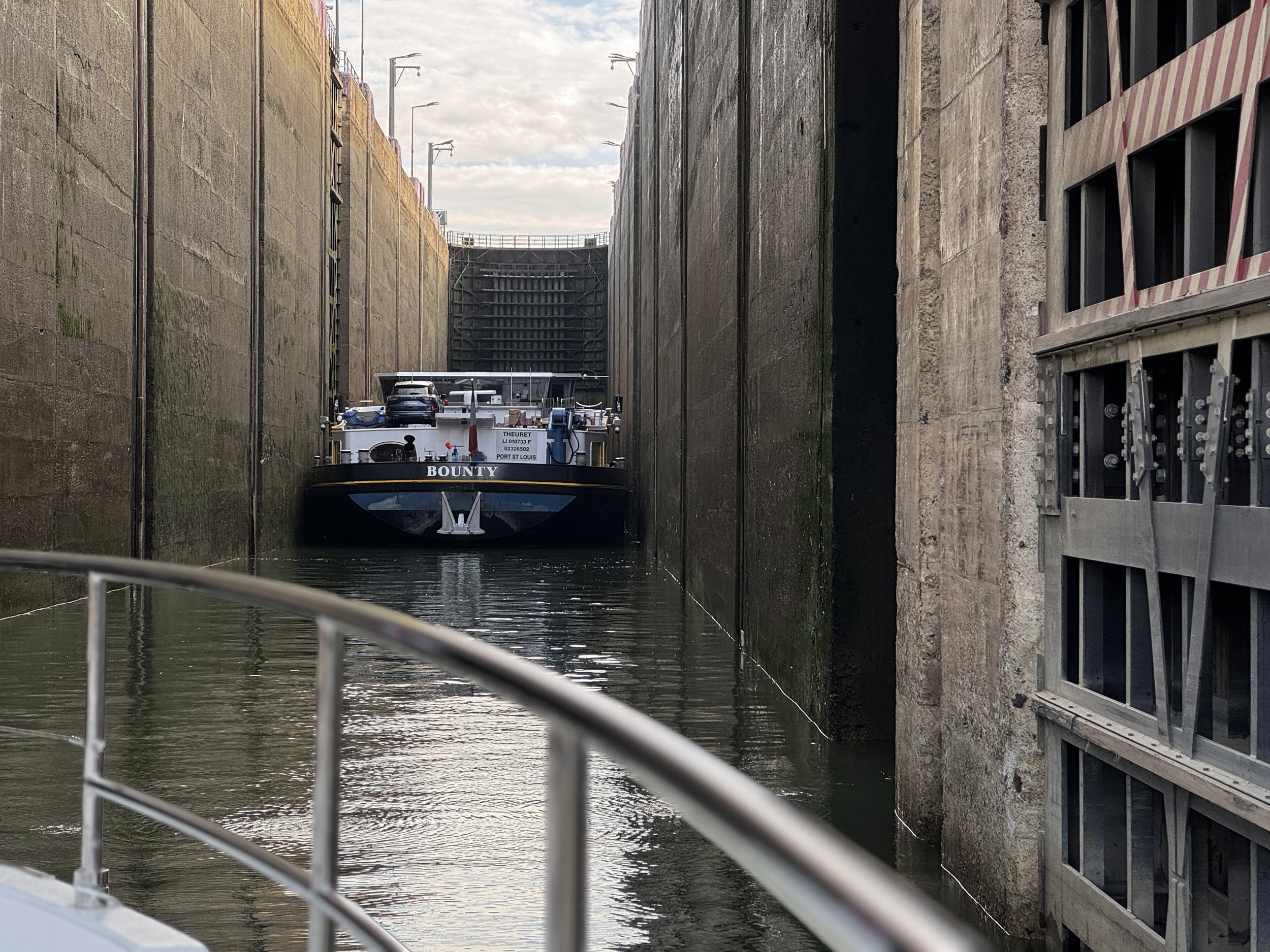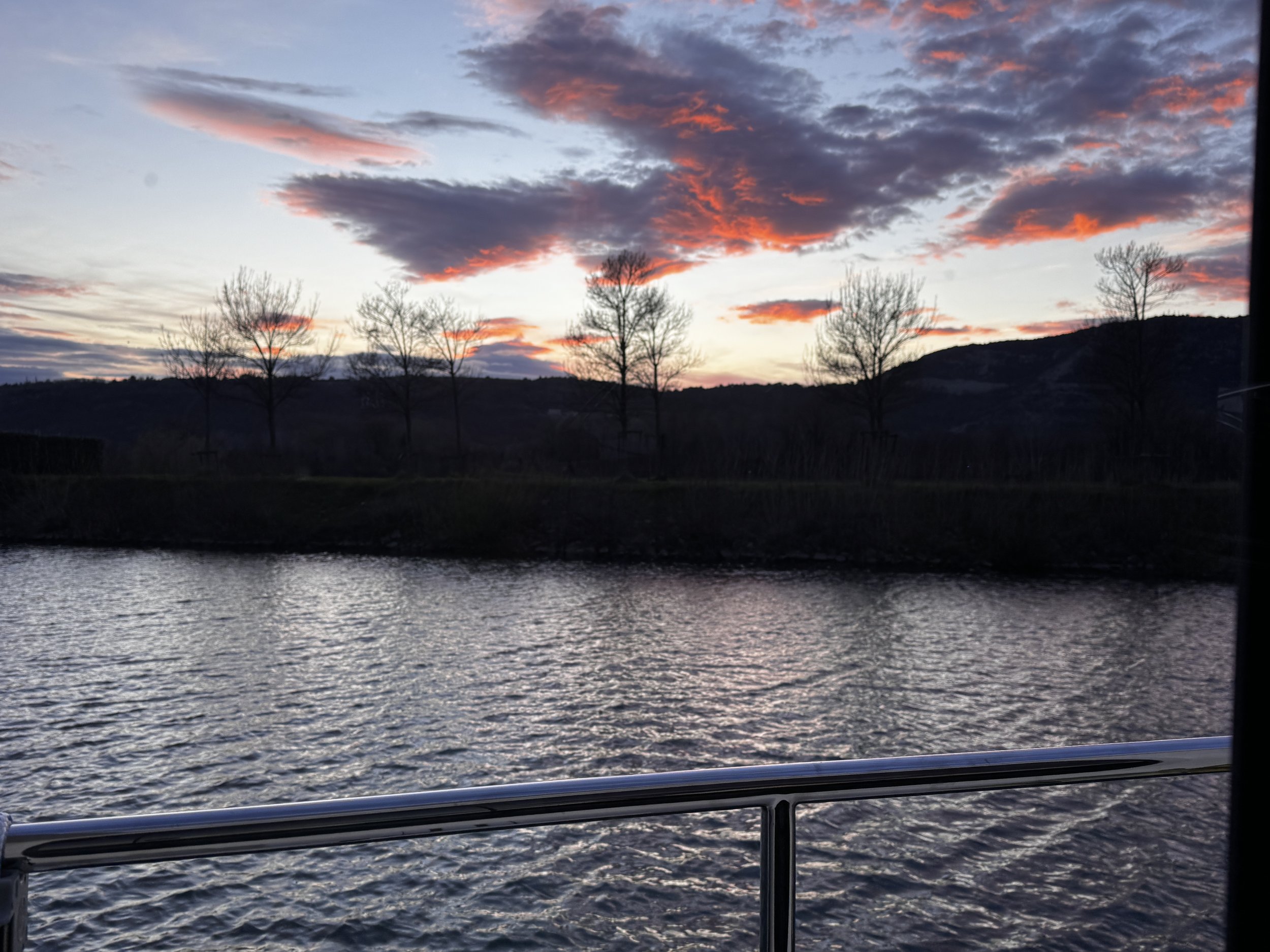A Singing Lock
We had planned to spend a few days in Avignon but there was heavy rain predicted and we wanted to get as far up the river as we could in case we got waylaid due to swift currents and flooding closures. We headed out early, the morning mist lifting gently into a clear blue sky.
We passed through our first lock within minutes of leaving the quay in Avignon and the next one we arrived at a couple of hours later. The locks were beginning to feel commonplace now, we had a streamlined system for “locking-up” so there were no surprises, though I definitely feel like a tiny skiff in these enormous cavities. Communication with the lock-keepers has also improved and I’m no longer flustered when I hear a perplexing response.
Five kilometers further upstream we passed a large nuclear power station. With it’s strong and regular flow, the Rhône River is a great cooling source for the reactors. This would be the first of many we would pass along the way.
The river was full of debris in places and we cautiously hand steered the best we could around lumber, logs and submerged trees that were being carried away. Bumping into pieces of wood was unavoidable and we both cringed every time we heard something knock against the hull. As we were leaving the flat river delta behind, the landscape was changing as well. Forests and rolling hills appeared in the distance while along the wide river were open plains and gentle slopes dotted with vineyards. Fields of lavender and olive trees skirt the hillsides.
















I read that 27 grape varieties are cultivated in this region including Syrah, Viognier, Marsanne and Roussanne. The average annual sunshine in the Côtes du Rhône - which translates to hillsides or slopes of the Rhône, is among the highest in France (an impressive 2,500-2,800 hours of sunlight) and the wines lean more towards a warm-climate style, smooth and rich with ripe fruit flavors and less acidity. You can bet I will be sampling some!
Our next lock for the day was Bollene. This is the most powerful hydroelectric power station on the river. It took four years to build and has an impressive drop of 22 meters (72 feet) - the highest not only in the French waterways but on the entire European network. I radioed the lock-keeper and we were asked to wait for a boat also approaching from downstream. A large barge, Bounty, crept past us and entered the mouth of the lock. The Bounty is 110 meters (360 feet) long and 11 meters wide (36 feet). There was barely any space between it and the walls of the lock on either side, no room for fenders just thin rubber bumpers on the gunnels. We were instructed to follow them in. Up until now we had mounted all the locks solo. As I secured our lines to a bollard in the back of the chamber, I noticed that the massive downstream gate was curved, not flat, presumably a stronger shape for the volume of water it needed to contain. For such a massive lock everything happened very quickly and we ascended smoothly as if in an elevator. When Bounty revved its engine to exit, the prop wash jostled us back and forth against the wall but we held fast.





It was nearing evening and we once again needed to find a stopping place. The charts indicated there were no pontoons or public quays within several hours. We approached another lock and I called and asked if we could overnight at the waiting pontoon. They were happy to oblige. As it happened, this float was well out of the flow of the river and there was no spillway at the dam. We felt well secured and slept deeply.




Another long day followed, we were closing in on the town of Valence where there is an actual marina with space for 420 boats. I had emailed ahead and received a prompt response that they had plenty of room for us. What a welcome change to have a plan. As high winds and heavy rains were still looming it would be the perfect place to wait out the coming storm and observe what changes, if any, the weather caused on the river.
The day passed slowly as we took turns navigating around partially swamped trees, evaded whirlpools and powered through fast currents. We reached the next lock and the gate lifted open, rising up like a guillotine. This time I was prepared and stood under the roof as we entered so that I didn't get an impromptu shower. All went as expected until we approached the top of the ascent and the water simply stopped rising. We were still about a meter and a half (5ft) from the top but were no longer moving. As we were close to the back of the chamber I noticed some men working up above on the bridge. They kept ratcheting different things and then turning around and looking at us as if pondering if we were moving. While we held tight lashed to the bollard, Tom and I discussed what would happen if the lock broke completely while we were inside. We figured we would have to climb the slimy steel ladder up and out into the daylight. Not a pleasant thought - but at least in this case we were only a few rungs from the surface. We bided our time for about 20 minutes and finally began to rise again. I gave a thumbs up to the men on the bridge and they all smiled and returned the gesture. Away we went.











Our final lock for the day started out like all the others. The lock gates closed behind us, a steel gate rose up out of the water to seal the area and we began our ascent. The bollard I was holding onto creaked, the sound of metal against metal. I realized it was a musical note though my untrained ear couldn't tell you which one. The other bollards began making their own ringing sounds and the combined effect echoed inside the chamber. The bass note of our idling engines resonated along with them, all the tones humming and reverberating to the rhythm of swirling water. It was nothing short of astonishing - like whale song or a piece of atonal music, quite overwhelmingly beautiful. The lock sang for the full fifteen minutes it took for us to ascend. It was mysterious and brought a astounding sense of peace given we were deep within a concrete chamber - I was in awe.
Later that afternoon as we approached Valence a whole new kind of traffic appeared on the river. Kite boarders zipped by in front and jumped our wake behind leaving but a couple of meters between us. Then something baffling appeared ahead on the water and was unable to identify it until it became airborne and buzzed just over our heads - I was not impressed!
We pulled into the marina and were greeted with a super warm welcome by the office staff. They gave us maps of the area, showed us the walking trails and bike paths and even offered to drive us to the large supermarket if we needed assistance. It felt good to be off the river for a bit. Traveling upstream is not difficult, we basically steer with the push of a button - staying in the channel by altering a few degrees to one side, then a few degrees back. And yet, there is a palpable effort you feel pushing against the current. We are traveling along the path of most resistance and it requires staying focused on that which we can control, and reframing the rest (closures and delays) as opportunities. I was certain the coming stationary days would rejuvenate me.






Valence is a city at a crossroads. In the 15th century, it was literally the gateway sitting on the border between the kingdom of France and the Holy Roman Empire. And since the Rhône River has been an important “highway” from north to south for centuries, Valence has always played an important role in river transport. It still claims to have the largest marina for private watercraft on the Rhône.
Heading towards the medieval part of the city we walked through several enormous parks. The largest being the Parc Jouvet which is spread across the lower terraces of the city facing the Rhône River, and encompasses 17 acres of woods, flowers, and open expanses of grass – with fountains and water features throughout. The magnolias and cherry trees were in full bloom as well as the daffodils and tulips.





It is a lovely small city with a population around 64,000. It’s sophisticated for its size – one of its leading families put the city on the map as one of the great destinations for gourmet dining in France! It has two places with one Michelin star each and another 3-star restaurant. André Pic was the first in this distinguished line of famous French chefs; Michelin first awarded three-star ratings in 1931, and Pic got three for his restaurant in Valence in 1939.





The next day was overcast but still no wind or rain so we decided to work on re-rigging our dinghy. We would be leaving the Rhône in about a week and moving into smaller, less commercial waterways which meant lower bridges - amongst other things. We had purchased what we needed to build a davit off the stern so that we could carry Raki behind the swim platform. This required playing tetris once again with the things we’d already lashed to the roof but Raki is now riding happily aft of Meraki where I can keep a vigilant eye on her.








After the predicted storm subsided, Tom rode his bike to the hardware store while I swabbed the decks, cleaned house and did some baking. That evening I tried my hand at rolling sushi for dinner. My mistake - I should have cleaned the house after dinner!
Note: photo captions do not appear if viewing on a cell phone.







